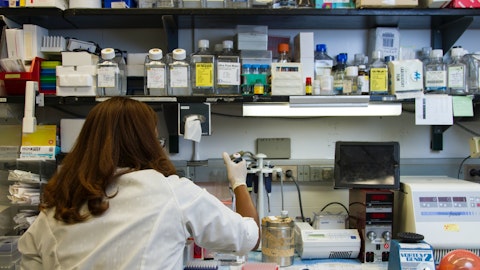Ultragenyx Pharmaceutical Inc. (NASDAQ:RARE) Q4 2023 Earnings Call Transcript February 15, 2024
Ultragenyx Pharmaceutical Inc. beats earnings expectations. Reported EPS is $-1.52, expectations were $-1.65. Ultragenyx Pharmaceutical Inc. isn’t one of the 30 most popular stocks among hedge funds at the end of the third quarter (see the details here).
Operator: Good afternoon, and welcome to the Ultragenyx Fourth Quarter and Full Year 2023 Financial Results Conference Call. . At this time, all participants are in a listen-only mode. At the end of the prepared remarks, you will have an opportunity to ask questions during the Q&A portion of the call. It is now my pleasure to turn to Josh — turn the call to Joshua Higa, Vice President of Investor Relations.
Joshua Higa: Thank you. We have issued a press release detailing our financial results, which you can find on our website at ultragenyx.com. Joining me on this call are Emil Kakkis, Chief Executive Officer and President, Erik Harris, Chief Commercial Officer; Howard Horn, Chief Financial Officer; and Eric Crombez, Chief Medical Officer. I’d like to remind everyone that during today’s call, we will be making forward-looking statements. These statements are subject to certain risks and uncertainties and our actual results may differ materially. Please refer to the risk factors discussed in our latest SEC filings. I’ll now turn the call over to Emil.
Emil Kakkis: Thanks, Josh, and good afternoon, everyone. In 2023, we generated significant momentum across our commercial and clinical programs that have set us up for Catalyst bridge 2024. On the commercial front, we progressed international regulatory and reimbursement negotiations across our marketed products, continuing to add to new approvals and positive reimbursement decisions. This geographic expansion along with growing demand in our existing markets put us in position to maintain our trajectory of robust year-over-year growth. On the clinical side, we released new data on our key programs in 2023 and successfully advanced enrollment of our priority programs that can accelerate value creation for our company this year and in the coming years.
At our Analyst Day in October, we shared exciting data from three programs that all will have additional data catalysts in 2024. On UX 143 for osteogenesis imperfecta, the interim Phase II data showed substantial increases in bone real density and Z score after just six months of treatment. This led to a 67% reduction in analyzed fracture with 20 of the 24 patients showing no radiographically confirmed fractures at six months. On GTX-102 for Angelman syndrome, data from the long-term extension cohorts Phase I/II study demonstrated clinically meaningful improvements across multiple neuro-developmental domains, including cognition, receptive communication, growth motors, behavior and fleet. These data show we can repeatedly dose GTX-102 for much longer than one year with acceptable safety profile.
On UX701 for Wilson disease, the data we presented showed four or five patients in the lowest dose cohort have begun tapering their standard of care, including two who are completely off key letters and/or zinc therapy. While still early for the UX701 program, we are encouraged by the data we have observed. Our momentum is continuing into 2024 with multiple clinical development updates. Last week, GTX-102 was granted priority medicine or PRIME designation by the European Medical authority based on the positive early clinical data from the long-term extension cohorts and the potential of GTX-102 to address the unmet need for our treatment in this disease. The clinical data we’ve shared with The Street, along with positive U.S. and European regulatory interactions give us confidence that we will be able to navigate the development path for this program.
For UX-111 in San Filippo A syndrome, we released Phase III data last week from extension of newly treated patients at the WORLD Symposium Annual Research Meeting in San Diego. The results we shared demonstrated treatment with UX-111 resulted in rapid and sustained decreased levels of heparan sulfate in the cerebrospinal fluid and the sustained reductions in CSF heparan sulfate exposure over time was correlated with improved long-term cognitive development. Our discussions on an accelerated approval pathway with the FDA are ongoing, and we continue to believe there’s a strong case to be made in this program. Looking ahead, we are entering 2024 in a robust financial position with $777 million on the balance sheet, including proceeds from our equity offering in the Q4 that raised $326 million.
We’re also continuing to focus our spend and resources on the key clinical programs that will drive value for our company, many [indiscernible] in the coming months. Our Chief Medical Officer, Eric Crombez will view more of these updates in his section. There’s a lot to look forward to as we continue our efforts to lead the future of rare disease medicines. Now I’ll turn the call over to our Chief Commercial Officer, Erik Harris, to provide an update on our commercial efforts last year that led to a 20% revenue growth in 2023.
Erik Harris: Thank you, Emil, and good afternoon, everyone. I’ll start with Crysvita’s performance in North America. I want to remind everyone that on April 27, 2023, we successfully transitioned the promotion of Crysvita in the U.S. to Kyowa Kirin and that Crysvita will continue to generate growing revenue for our company. During the transition period, the Ultragenyx field team continued to find patients from community physicians, while introducing key accounts to Kyowa Kirin field teams. Our patient support services team supported the transition of patients from the Ultragenyx hub to the Kyowa Kirin hub to ensure continuity of treatment and reimbursement. In 2023, the smooth transition and additional field resourcing helped support the growing demand for Crysvita in the U.S. and Canada.
In fact, there were approximately 500 start forms generated in 2023 from a continually growing base of unique prescribers and patients on reimbursed therapy. The success we saw in 2023 and has led us to further amend our agreement with Kyowa Kirin that will allow our experienced field team from Ultragenyx to continue to support Crysvita in the U.S. through this year with a robust demand from 2023, a fully transitioned patient support services hub and the support of Ultragenyx’ focused field team, we feel confident that 2024 will be another strong year for Crysvita in North America. Shifting to Crysvita in Latin America. We finished the year with over 500 new patients on reimbursed therapy, which included approximately 50 new patients who began commercial therapy in Q4 of 2023.
Over the course of the year, we added approximately 200 nations to our growing base of patients on commercial therapy. While most of the current demand in Latin America is driven by pediatric patients, we are seeing an increasing uptake in adult patients across the region, reflecting a similar pattern that we saw in North America. In Latin America, we expect quarter-to-quarter variability in revenue driven by uneven ordering patterns but remain confident in the underlying demand growth for our products. These combined efforts across our global organization generated 2023 Crysvita revenue of $328 million, which is a 17% increase compared to 2022. For Dojolvi in the U.S. and Canada, the demand for start forms remains strong. In 2023, we added approximately 115 start forms and 95 patients on reimbursed therapy, resulting in over 470 reimbursed patients in the U.S. since launch.
The number of prescribers continue to grow, adding approximately 40 new prescribers in 2023. In Latin America, we are making steady progress in finding patients despite the lack of newborn screening in the region while expanding access for Dojolvi to more patients. Most recently in Mexico, Dojolvi was approved by the HCA for inclusion in the National Medicine Compendium, which is an important step toward increasing reimbursed patients in 2024. Across the EMEA region, the Dojolvi is driven by named patient sales request as we continue to deepen the awareness of LC-FAOD with key stakeholders through our medical teams. Though the majority of current requests are coming from France, we are seeing an increased demand throughout Europe and the Middle East.
In 2023, the teams generated $71 million in Dojolvi revenue, which is 27% growth compared to 2022. Lastly, on FSA, we continue progressing steadily across our launch markets in EMEA, Canada and Japan. In EMEA, European HTAs have provided infusion with positive clinical recommendations and we are working through the reimbursement processes. On December 18, we received approval from the European Commission for an expanded indication for Evkeeza in children aged five years and older with HOFH. This approval further validates the drug’s clinical value and expands the addressable patient population in the EMEA region. In Canada, both HTA bodies, CIS and NS have provided positive clinical recommendations for Evkeeza. The team is prepared — is preparing to accelerate the public reimbursement process with the Canadian authorities in the coming months.

In the meantime, we are working to give private payers on board to expedite reimbursement. The initial uptake on the start forms has been steady since Health Canada’s approval. In Japan, we received regulatory approval on January 18 and pricing discussions are underway with Japanese authorities. Following reimbursement approval, we expect to launch Evkeeza in Japan next quarter. The team is busy educating the physicians on the Evkeeza-label and identifying appropriate patients who could benefit from the treatment. Building on the success in 2023, we expect continued strong performance across our portfolio in 2024. Crysvita will continue to drive the majority of the revenue followed by Dojolvi and Evkeeza. With that, I’ll turn the call to Howard to share more details on our financial results and 2024 guidance.
Howard Horn: Thanks, Erik, and good afternoon, everyone. I’ll focus on full year corporate financials since we just covered our individual product performance. Starting with total revenue. For 2023, we reported $434 million representing 20% growth over 2022. Total operating expenses for the year were $1 billion, which included R&D expenses of $648 million, SG&A expenses of $310 million and cost sales of $45 million. Operating expenses included noncash stock — noncash stock-based compensation of $135 million. For the year, net loss was $607 million or $8.25 per share. As of December 31, we had $777 million in cash, cash equivalents and marketable securities. In 2023, net cash used in operations was $475 million, which was higher than forecasted due to timing of when certain receipts and payments landed around year-end.
Our 2024 net cash used in operations is expected to be less than $400 million which is consistent with the guidance we provided last month. We are also reaffirming the 2024 revenue guidance ranges we stated last month. Total revenue is expected to be between $500 million and $530 million, which represents 15% to 22% growth versus 2023. Crysvita revenue is expected to be between $375 million and $400 million, which includes all regions and all forms of Crysvita revenue to Ultragenyx. Specifically, it includes Crysvita product revenue from Latin America and Turkey and the cash and noncash royalties from North America and Europe. Our Crysvita guidance range represents 14% to 22% growth versus 2023. Dojolvi revenue is expected to be between $75 million and $80 million, which represents 3% to 13% — excuse me, 6% to 13% growth versus 2023.
Our Dojolvi projections represent a blend of faster growth in countries where we commercialize and lower growth in countries where we respond to name patient requests. With that, I’ll turn the call to our CMO, Eric Crombez, who will provide an update on our key clinical data readouts expected this year.
Eric Crombez: Thank you, Howard, and good afternoon, everyone. In addition to the UX-111 Phase III data that we presented at the WORLD Symposium last week, we have a number of important clinical data readouts planned for 2024. These include GTX-102 expansion cohort data to be presented mid-first half, DTX401 Phase III data in the second quarter, then UX701 dose-finding data, and finally, UX-143, longer-term follow-up data from the Phase II part of the ongoing Phase II/III study. For UX-143, there is also the potential for the Phase III study to read out pivotal data from the first interim analysis around the end of the year. We have set a strict p value of 0.001 for un-blinding for this first interim analysis. This means that the alpha spend is effectively 0 while providing the opportunity to end the study early if the data are compelling and the primary endpoint is met.
We have also built in a second interim and final analysis for the study that would occur in 2025. We Regardless of the timing, the reduction in the annualized fracture rate that we saw in the Phase II study and shared at ASBMR last year gives us confidence that we will see a clinically meaningful and statistically significant reduction in clinical fracture rate in the Phase III study. Shifting now to the two near-term data readouts for GTX-102 and DTX401. I’ll start with GTX-102 for the potential treatment of Angelman syndrome and the Phase II expansion cohort data that we expect to share in the next few months. The first part of the study included a dose escalation stage to understand initial safety and efficacy. Last October, at our Analyst Day event in New York, we disclosed longer-term extension data, demonstrating clinically meaningful improvements across multiple domains for the patients in these extension cohorts.
We also showed the first ever developmental milestones that many of these patients have achieved to highlight the clinical meaningfulness of these changes. Earlier last year, we began dosing a larger number of patients in expansion cohorts to further study the dose regimen that we intend to evaluate in a Phase III trial. These expansion cohorts include higher loading doses and enrollment was completed at the end of last year with 53 patients enrolled globally. The upcoming expansion cohort data in mid-first half of this year will focus on the 20-plus patients who have been on therapy for at least 170 days. We intend to present safety and efficacy data in a similar format to what was shown at Analyst Day, specifically showing domain by no main changes with comparisons to natural history.
With higher loading doses and a greater number of patients, we expect to verify the meaningful efficacy that was presented at Analyst Day. These data will inform dose selection and evaluation period for the Phase III study. Our discussions with the FDA on Phase III planning continue to go well, and we anticipate that the expansion data will support an end of Phase II meeting in mid-2024, which will enable Phase III study start up later in 2024. The next near-term data readout is for DTX401 and our investigational gene therapy for the treatment of glycogen storage disease type Ia. We have one of the largest late-stage gene therapy pipeline, and this will be our first Phase III data readout. All of the patients in the Phase I/II demonstrated a clinically meaningful response to DTX401 that has proven durable with the earliest treated patients entering their fifth year of follow-up.
In the randomized, placebo-controlled Phase III study, we expect to see patients with clinically meaningful and statistically significant reductions in cornstarch therapy. We expect to unblind and share top line data from the DTX401 Phase III study in the second quarter of this year. I’ll now turn the call back to Emil to provide some closing remarks.
Emil Kakkis: Thank you, Eric. We’ve made incredible progress across the clinical pipeline, which sets us up for a number of data catalysts this year. I’ll close by summarizing those catalysts, everyone get a better sense of what to expect. As Eric mentioned, in the next few months, we’ll share the expansion cohort data from the GTX-102 Phase II study. This is expected to be followed by the top line Phase III DTX401 data in the second quarter. Next, we plan on sharing the UX701 for Wilson disease Stage one data in mid-2024. This will be data from the three dose escalation cohorts that recently dosed the last patient. Closing with UX-143 for osteogenesis imperfecta, we expect to share longer-term Phase II data in the second half of the year.
Enrollment in the Phase III studies is going well, and we are on track to complete enrollment with approximately 150 patients in the Orbit study around the end of the first quarter. The compact study is also enrolling well and is on track to enroll approximately 50 patients or more around the same time or just after. 2024 is an important year for Ultragenyx. We’ll continue expanding global access to our commercial products, bringing these important therapies to more and more patients is expected to generate more than $500 million in revenue and support our path toward profitability. We also expect to share meaningful updates from four of our later stage clinical programs, making this one of the most data-rich years in our company’s history.
With that, let’s move on to your questions. Operator, please provide the Q&A instructions.
Operator: [Operator Instructions]. Our first question will come from the line of Gena Wang with Barclays.
See also Top 16 Aircraft Manufacturers In The World and Top 20 Motorcycle Brands in the World.
Q&A Session
Follow Ultragenyx Pharmaceutical Inc. (NASDAQ:RARE)
Follow Ultragenyx Pharmaceutical Inc. (NASDAQ:RARE)
Gena Wang: I have one question regarding the GTX-102 in Angelman and one for setrusumab. So for GTX-102, you received the prime designation, what is the early feedback regarding approval path and the Phase III trial design? And have you met with the FDA also regarding the Phase III trial design? And for setrusumab, how will long-term Phase II data in the second half ’24 will inform the first interim for obvious Phase III before year-end ’24.
Emil Kakkis: Very good. Thanks, Gena, for the question. So the prime designation was just a presentation of the data that we’ve seen so far. And basically recognize the close of data we saw. We have not settled on a Phase III plan with the European authorities that’s something to become. With regard to the FDA the prime designation will have no influence on the FDA. We have initiated our conversations with FDA. We’ve had good discussions. We’re making good progress, and we feel comfortable about putting together a plan when we have our Phase II data in hand when we meet them with end of Phase II, but we’re encouraged by the discussion and think there’s a way forward in terms of finalizing the plan for Phase III. We have said just for reference that we’re planning the Phase III to be around 100 to 120 patients in a randomized double-blind trial design, and the FDA knows that.
And I think that’s a traditional design. I don’t think there should be any problem with European authorities either with that basic design. So we’ll get the Phase II endpoint — I mean, Phase III endpoint settle as we move through getting all the data. With setrusumab Phase I data will tell us a little more about the fracture reduction rate over a longer period of time. It appeared from before there were very few fractures after the 5, 6, seven month of treatment, and we’ll get a lot more patients now out further to give us a good sense of the level of reduction over longer periods of time. And that will help us understand the true maximum effect that we might see on fracture reduction. Since the fracture reduction is up already at the 67% estimate rate that puts us in good position to potentially have a positive interim.
It will depend on the variation we see in patients. But we felt that, that level of efficacy and any higher efficacy would put us in a position to potentially being able to end the study sooner if we have profound highly statistically significant results. We could have a very good result that we still not hit that standard, and we’ll have another interim and final in 2025. So we’re very encouraged about setrusumab in the path forward. And the Phase II data shall help us see how great it is and understand a little bit more about the path forward.
Operator: One moment for our next question. And that will come from the line of Maury Raycroft with Jefferies.
Maurice Raycroft: Based on the totality of your Angelman data so far, including data from your natural history longitudinal study. As you think about a Phase III design, do you have a sense of what the optimal time frame is to assess efficacy and what age group could show maximum benefits?
Emil Kakkis: Yes. So if you look at the study data we put out last year at Analyst Day, we’ve continued to gain ground over time, right? So it looks like going a little longer, like day 170 is early. And if you look at day 254, the data looks much stronger. And our view is it could be anywhere from around day 254 to day 330. Somewhere in that range is the likely time frame we would do the study. Obviously, the longer it is, that means the more time on placebo. It gives more time for separation of the groups, but it’s somewhere in that time frame. And the Phase II data will help us try to figure out what’s the right number. I’d want to do the study, not a long longer than it needs to be meaningful for found results. In terms of age, I think right now, our plan is to continue with the same age range we’re using in the Phase II, the 4- to 17-year-old early on, people thought only young patients would respond, but we’ve been seeing good responses in older kids, too.
So I don’t think that should limit we shouldn’t need to limit that in order to get the best efficacy. I think we conclude that whole group four to 17 in our Phase III design. Our expectation though is to do a separate study, an open-label study to help look at younger kids, potentially older kids and the other generic types to fill out the data set. With the main Phase III study, we expect to be 4- to 17-year-old and be somewhere between 250 days to 330 days long.
Operator: And one moment for our next question. And that will come from the line of Anupam Rama with JPMorgan.
Anupam Rama: Maybe just a quick one for me. What was the feedback on the 111 program MPS III program update at WORLD? And where are you there with the FDA discussions in terms of what are the push-pull levers here on like an accelerated approval process in meeting.
Emil Kakkis: Well, in the meeting there, we had really positive feedback from people because I think the extended data is continuing to show good developmental progression among the longer treated patients. That’s consistent with the heparan sulfate and being predictive of good clinical outcomes. And so we’re encouraged and there’s been a number of people using the HF marker and showing similar predictive value. So FDA has been going on for a while. I think Peter Marks has been very encouraged with the idea that we should be moving with biomarker than the workshops planned organized by Reagan Udall, February 21. And which will look at heparan sulfate across multiple programs. We feel the data there should encourage the FDA to take the stand of accepting heparan sulfate as a reasonably likely to predict clinical benefit marker and start doing solid approvals in the MPS brain disease area, which if it happens, I believe, will help us move forward in other rare genetic disorders, particularly that affect the brain.
So I think we’re encouraged about the progress forward on the workshop, the data we released, the data others have released tell us that we have a handle on how to treat MPS disease and particularly MPS-IIIA and that’s a good thing because there hasn’t been a single trend for MPS brain disease approved today.
Operator: Thank you. One moment for our next question. And that will come from the line of Tazeen Ahmad with Bank of America.
Tazeen Ahmad: Sorry for the background noise. I have a couple just on 701 for Wilson. You’ve changed the readout time line. I think originally it was first half, and now you’re saying it’s mid-2024. Is just that — is that just nomenclature or was there a reason for a slight time shift? And then I guess going back to Angelman, a question that we’ve been getting a lot of recently is with relation to the composite endpoint that we’ve talked about that includes measures, including Baily and CGI, but have you had detailed discussions with FDA on using that composite endpoint. And I think the main question around that is coming from the potential of a competitor to have their own Angelman data around the same time as yours. And how that might affect the FDA’s viewpoint of using a more traditional endpoint?
Emil Kakkis: Okay. So the time line and Wilson has done on the last patient role. We enrolled the last patient cohort just early this year. We want to give them enough time at least six months to kind of have an opportunity to titrate their key layers, get through the whole treatment process and titrate key layers. So it’s slightly off from different from where we have but not meaningfully. So that’s the timing. We want to make sure to give patients enough time to be able to get off their key layers if they can. So that’s the basic story there. With GTX-102, we’ve had discussions on both MDI and other ways of looking at the endpoints of the FDA. And I think they’re open to various ways of looking, and I think they showed a lot of flexibility in many ways.
Whether we do MDRI now will be just a question whether we want to press our case on using something novel or whether we should stick to picking a traditional single endpoint or two endpoints for the primary. But we’re still working through that with FDA. I think it’s been good. But I’m not really worried about the competitor. Honestly, our efficacy will be the driver of what we do. I don’t think that there — a competitor is going to change the outcome on the end points. They are behind us at this point. And I think the efficacy data they put out has not been impressive. So at this point, I think our future is all in our hands. And honestly, I think we have some of the best team in developing endpoints, methodology around it and support for it.
And nothing in our conversations when the FDA suggests that they’re listening to anyone else, particularly in this. They seem to be willing and able and ready to work with us on a final solution on the endpoint.
Operator: Thank you. One moment for our next question. And that will come from the line of Dae Gon Ha with Stifel.
Dae Gon Ha: I’ll just ask two on GSD1a. I guess the first one is, Emil, can you shed some more insights on the cornstarch reduction. So we’ve heard from some docs that sleeping through the night is also as important, if not more important, than the reduction itself. So when you think about the outcome here, what do you consider a clinically meaningful level corn starch reduction? And what data will you provide to address the sleeping aspect for the physicians? And then kind of sticking with GSD1a. Can you talk about the training and monitoring of these investigators to ensure the cornstarch reduction is done appropriately versus just slower than expected out of caution?
Emil Kakkis: I’ll deal with the first question, then maybe Eric, you could deal with the second question about the training of the sites and so forth. So we haven’t set a minimum threshold of change for cornstarch because we agree with you that, what is probably more important than the actual reduction is whether the patients are critically dependent on corn starch to survive. Because the problem with cornstarch is not taking cornstarch. The problem is that each patient lives each day with a gun to its head thinking, if I forget to make cornstarch, I could die, as a horrible burden on live with and have to take something every three hours. So what we know from our Phase I/II study is that patients — many patients were able to have no cornstarch at night and their blue pulses were maintained.
They did not drop to 0. They were maintained and supported. So what data will we have? Well, we’re looking at primary clinical — statistical significance and cornstarch reduction. We’ll also look at the number of cornstarch administration they take, whether they’re taking at night, we’ll have tedious glucose monitoring, which allows us to monitor glucose control during the night, which will also be something we’ll be looking at. So in addition to the cornstarch, you will hear about the other characterization of the cornstarch dependency, which I think are an important part of the story. And it’s an important part why the amount of reduction we’re seeing is transformed for patients where they feel like they can go out of the house and exercise without feeling that they’re going to get hypoglycemic can drop somewhere.
And we’ve had many patients tell us they feel safe now that that’s not going to happen to them. And many who don’t take starch at night and sleep through the night. So I think those are all aspects of what will come out with the Phase III data to help provide the clinical meaningful argument in addition to the quantitative around corn start reduction. Now Eric, maybe you can provide a little more on the training and how we’re doing this with sites.
Eric Crombez: Yes. To your point, the training and monitoring is very important here. We really did want to rely on our study teams, principal investigators who gained a lot of experience during the Phase III part of this program to continue on as trial sites for the Phase III. Because of the double-blind nature of the Phase III study, we also wanted to build an independent group of experts physicians truly the biggest experts in GSD1a who aren’t participating in clinical trial sites to really work with the sites and guide them to make sure we’re doing this consistently and safely.
Operator: And one moment for our next question, and that will come from the line of Joon Lee with Truist Securities.
Mehdi Goudarzi: This is Mahdi on for Joon. I have two questions. Could you please provide some clarification on the patient mix that you are envisioning for Phase III, would you exclude UPD patients or like patients with prior experience with ASOs. And the other question is on setrusumab, what gives you confidence that a potential chronic dosing would be on the label for this treatment?
Emil Kakkis: Yes. So you’re speaking of GTX-102. Correct. So for the gene types, we’re going to stick to the gene times we have been studying, which is the deletion type, which is 70% of the patients, the UPD and misses patients wouldn’t be in the randomized control Phase III. But our intent is to provide a basket study where we’ll look at a cohort of those type patients open label to help look at their efficacy and tried support for conclusion on the label, but they won’t be part of Phase III because we — as a habit and method within the company, we don’t expand genetic types of patients we haven’t treated if we haven’t studied them already in Phase II. So it will — the Phase III will be all deletion type. So those are the most severe patients, improving benefit in the most severe patients, I think, puts us on path to be able to support efficacy with smaller studies to deal with the other types.
Now patients who had prior experience, for example, patients have been on the Roche program. We’ve had a number of Roche patient acquirer. The challenge is very complicating right now, particularly for those that had safety events and another ASO to drop into a Phase III study. It’s not something we would do. We’re going to look at ways what we can do to look at access for those patients going forward in our program. We just haven’t done it yet. We still have to work out our safety net and efficacy we take on those complexities. But there’s certainly patients interested in crossing over at this point in time. And so remind me the last question you had was on which program?
Mehdi Goudarzi: I believe its chronic dosing product dosing for OI.





